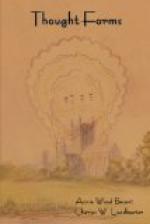It is obvious that, if time and capacity permitted, hundreds of volumes might be filled with drawings of the forms built by different pieces of music under different conditions, so that the most that can be done within any reasonable compass is to give a few examples of the leading types. It has been decided for the purposes of this book to limit these to three, to take types of music presenting readily recognisable contrasts, and for the sake of simplicity in comparison to present them all as they appeared when played upon the same instrument—a very fine church organ. In each of our Plates the church shows as well as the thought-form which towers far into the air above it; and it should be remembered that though the drawings are on very different scales the church is the same in all three cases, and consequently the relative size of the sound-form can easily be calculated. The actual height of the tower of the church is just under a hundred feet, so it will be seen that the sound-form produced by a powerful organ is enormous in size.
Such forms remain as coherent erections for some considerable time—an hour or two at least; and during all that time they are radiating forth their characteristic vibrations in every direction, just as our thought-forms do; and if the music be good, the effect of those vibrations cannot but be uplifting to every man upon whose vehicles they play. Thus the community owes a very real debt of gratitude to the musician who pours forth such helpful influences, for he may affect for good hundreds whom he never saw and will never know upon the physical plane.
Mendelssohn.—The first of such forms, a comparatively small and simple one, is drawn for us in Plate M. It will be seen that we have here a shape roughly representing that of a balloon, having a scalloped outline consisting of a double violet line. Within that there is an arrangement of variously-coloured lines moving almost parallel with this outline; and then another somewhat similar arrangement which seems to cross and interpenetrate the first. Both of these sets of lines evidently start from the organ within the church, and consequently pass upward through its roof in their course, physical matter being clearly no obstacle to their formation. In the hollow centre of the form float a number of small crescents arranged apparently in four vertical lines.
[Illustration: PLATE M. MUSIC OF MENDELSSOHN]
Let us endeavour now to give some clue to the meaning of all this, which may well seem so bewildering to the novice, and to explain in some measure how it comes into existence. It must be recollected that this is a melody of simple character played once through, and that consequently we can analyse the form in a way that would be quite impossible with a larger and more complicated specimen. Yet even in this case we cannot give all the details, as will presently be seen. Disregarding for the moment the scalloped




